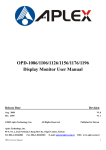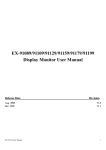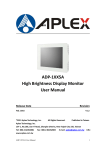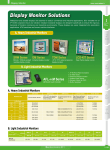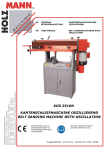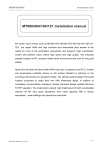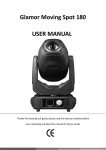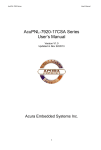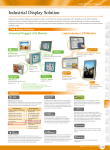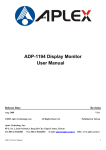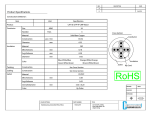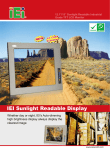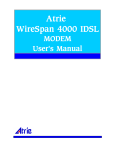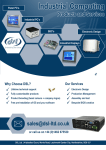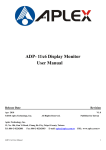Download Figures
Transcript
OPD-1086/1106/1126/1156/1176/1196 Display Monitor User Manual Release Date Revision Nov. 2014 ® 2014 Aplex Technology, Inc. V1.2 All Rights Reserved. Published in Taiwan Aplex Technology, Inc. 9F-5, No. 2, Jian Pa Road, Chung Ho City, Taipei County, Taiwan Tel: 886-2-82262881 Fax: 886-2-82262883 E-mail: [email protected] www.aplex.com.tw OPD-11x6 User Manual URL: 1 Warning!___________________________________ This equipment generates, uses and can radiate radio frequency energy and if not installed and used in accordance with the instructions manual may cause interference to radio communications. It has been tested and found to comply with the limits for a Class A computing device pursuant to FCC Rules, which are designed to provide reasonable protection against such interference when operated in a commercial environment. Operation of this equipment in a residential area is likely to cause interference in which case the user at his own expense will be required to take whatever measures may be required to correct the interference. Electric Shock Hazard – Do not operate the machine with its back cover removed. There are dangerous high voltages inside. OPD-11x6 User Manual 2 Table of Contents______________________ Warning!…………………………………………………………………………….……..….2 Chapter 1 Getting Started 1.1 Features………………………………………………………….………….5 1.2 Specifications…………………………………………. ...……………...….5 1.3 Dimensions…………………………………...………………………….…7 1.4 Brief Description..................................................................................10 1.5 Display Mode………………………………………………………………11 Chapter 2 OSD 2.1 OSD Functions….……………….……………………………….…..…….12 2.2 OSD Controls………………………………………………………………13 2.3 Main Menu…..……………………………………………………………..14 Chapter 3 Control Board 3.1 Introduction to the PenMount 9036CH5 Touch Screen Control Board (For RS-232 interface Touch Screen)…………………………...……………….16 3.2 Introduction to the PenMount 6300A5 Touch Screen Control Board (For USB interface Touch Screen)………………………………….……………19 Chapter 4 Installation 4.1 Windows XP/2003/Vista/Win7 Driver Installation for PenMount 9036CH5/6300A5 Control Board……………………………………………22 4.2 Configuring the PenMount Windows XP/2003/Vista/Win7 Driver25 4.3 Uninstall the PenMount Windows XP/2003/Vista/Win7 Driver……32 Chapter 5 Software 5.1 Software Functions…………………………………………………………33 5.2 Software Function Descriptions……………………..……………….…..34 Figures Figure 1.1: Dimensions of OPD-1086….……………………………………..7 Figure 1.2: Dimensions of OPD-1106….……………………………………..7 Figure 1.3: Dimensions of OPD-1126….……………………………………..8 OPD-11x6 User Manual 3 Figure 1.4: Dimensions of OPD-1156…..…………………………………….8 Figure 1.5: Dimensions of OPD-1176….……………………………………..9 Figure 1.6: Dimensions of OPD-1196….……………………………………..9 Figure 1.7: Overall View………………………………………………………10 Figure 1.8: Rear View…………………..……………………………………..10 Figure 3.1: Overview of PenMount 9036CH5 Control Board………………16 Figure 3.2: Dimensions of PenMount 9036CH5 Control Board……………17 Figure 3.3 Overview of PenMount 6300A5 Control Board…………………19 Figure 3.4 Dimensions of PenMount 6300A5 Control Board…………………20 OPD-11x6 User Manual 4 Chapter 1________________Getting Started 1.1 Features Model OPD-1086 OPD-1106 OPD-1126 OPD-1156 Display 8” TFT LCD 10.4” TFT LCD 12.1” TFT LCD 15” TFT LCD Luminance 400 cd/m² 250 cd/m² 400 cd/m² 350 cd/m² OPD-1176 17” TFT LCD 300 cd/m² OPD-1196 19” TFT LCD 300 cd/m² Resistive touch screen (optional) Optional DVI, Video or S-Video input Supports wide-ranging resolutions from 640x480 to up to 1600 x 1200 with auto phase and auto position. 1.2 Specifications Display Model OPD-1086 OPD-1106 OPD-1126 OPD-1156 OPD-1176 OPD-1196 Luminance 400 cd/m² 250 cd/m² 400 cd/m² 350 cd/m² 300 cd/m² 300 cd/m² Viewing Angle H:125/V:140 H:130/V:110 H:160/V:140 H:150/V:140 H:140/V130 H:160/V:160 Resolution 800x600 800x600 800x600 1024x768 1280x1024 1280x1024 Backlight lifetime 40000hrs 20000hrs 50000hrs 50000hrs 50000hrs 50000hrs Touch Screen Resistive touch screen (optional) OSD Control Indicators Automatic screen, setup (OSD), brightness, contrast, horizontal/vertical position, image lock, color balance, video information, power on and sync detected OS Compatibility Power Input Win XP Input 11~32V/DC Environment Operating Temperature: 0~50˚C (32˚~122˚F) Storage Temperature: -20~60˚C (-4˚~140˚F) Relative Humidity: 10~90% @40˚C non-condensing, without touch screen Vibration: 1g peak, 5~500Hz (at random) Shock: 10G peak acceleration (11msec. duration)/operation Certifications: Meet CE, FCC Class A OPD-11x6 User Manual 5 Mechanical Model OPD-1086 OPD-1106 Construction Dimensions OPD-1126 OPD-1156 OPD-1176 OPD-1196 410x330mm 423x333mm Steel Chassis 208X148mm 260x213mm Mounting Type 300x250mm 357x291mm Panel Mount Ordering Information OPD-1086 8” SVGA open frame display monitor OPD-1106 10.4” SVGA open frame display monitor OPD-1126 12.1” SVGA open frame display monitor OPD-1156 15” XGA open frame display monitor OPD-1176 17” SXGA open frame display monitor OPD-1196 19” SXGA open frame display monitor Options Resistive touch screen OPD-11x6 User Manual 6 1.3 Dimensions Figure 1.1: Dimensions of the OPD-1086 Figure 1.2: Dimensions of the OPD-1106 OPD-11x6 User Manual 7 Figure 1.3: Dimensions of the OPD-1126 Figure 1.4: Dimensions of the OPD-1156 OPD-11x6 User Manual 8 Figure 1.5: Dimensions of the OPD-1176 Figure 1.6: Dimensions of the OPD-1196 OPD-11x6 User Manual 9 1.4 Brief Description of the OPD-11x6 The OPD-11x6 offers 8” / 10.4”/12.1/15”/17”/19” LCD open frame display the feature an excellent viewing ability for special monitoring and control applications, especially in Industrial area. It is available with resistive touch screen that is easy to use and maintain. Figure 1.7: Overall View of OPD-11x6 Figure 1.8: Rear View of OPD-11x6 OPD-11x6 User Manual 10 1.5 Display Mode Display Mode VGA 640 x 480 SVGA 800 x 600 XGA 1024 x 768 1152 x 864 SXGA 1280 x 1024 OPD-11x6 User Manual Hori. Sync (KHz) Vert. Sync. (Hz) 31 60 38 72 38 75 35 56 38 60 48 72 47 75 48 60 56 70 60 75 68 75 64 60 80 75 11 Chapter 2_________________________OSD 2.1 OSD Functions Power switch: To turn ON or OFF the power Shift the icon to the right side or shift it up Shift the icon to the left side or shift it down Menu: To enter OSD menu for related icon and item. Auto Button: One-touch auto adjustment 1.) Getting into Burn-in Mode Before setting into a burn-in mode, first disconnect the AC power cord. Then press (don’t let them go) the buttons until the AC power cord is connected and the “RGB” appears on the top left corner of your screen. Now it can be put into the burn-in mode for changing colors. 2.) Getting Out of Burn-in Mode Before getting out of the burn-in mode, please first disconnect the AC power cord. Then press the button (If not workable, press the button and don’t let them go) until the AC power cord is connected. Please don’t let your fingers go until the AC power cord is connected again and the wording of “RGB” appears on the top left corner of your screen, and wait for 3 second. Under the non-signal entry situation, if Cable Not Connected is seen, exit is thus successfully made. OPD-11x6 User Manual 12 2.2 OSD Controls To make any adjustment, select the following: 1. Press (Menu) to show the OSD menu or disable the OSD menu. 2. Select the icon that you wish to adjust with the ( / 3. Press (Menu) and then choose the item with the ( 4. Press (Menu) and then adjust the quality with the 1.) or +/-) key in the menu. or +/-) key. / ( / If the “RGB” is still on the top left corner of the screen, press choose “Reset”, and then Yes, and press or +/-) key. to enter “Miscellaneous” and . When the screen goes black, disconnect power and repeat the above steps. 2.) If the “RGB” is not found, disconnect the AC power cord first. Then press the 3.) (don’t let them go) until the AC power cord is connected, and wait for 2 to 3 seconds. When “RGB” appears, repeat the above steps. Functions of OSD Keys OPD-11x6 User Manual buttons 13 2.3 Main Menu In the Main menu, there are the following items: Color Image Setting Position OSD Menu Language Misc Exit For Color, check out the following: Contrast Brightness Color Adjust Color Temp Back For Image setting, check out the following: Clock OPD-11x6 User Manual Phase Gamma Sharpness Back 14 In the Position, there are the following: H. Position V. Position Back In the OSD menu, there are: OSD H. Pos. OSD V. Pos. OSD Timer Back In the Language menu, there are: English Frances Germany Spanish Traditional Chinese Simplified Chinese Japanese In the Misc menu, there are: Signal Source Select VGA: Analogue VGA Input Select DVI: Digital DVI-D Input Select AV: Composite Video Input Select SV: S-Video Video Input Reset Back OPD-11x6 User Manual 15 Chapter 3________________Control Board 3.1 Introduction to the PenMount 9036CH5 Touch Screen Control Board (For RS-232 interface Touch Screen) PenMount 9036CH5 Control board is a powerful RS-232 touch screen control board to support 5-wire touch screen by executing the same drivers as all PenMount series control board and ICs. PenMount 9036CH5 is good for all kinds of resistive touch screens, user could put PenMount 9036CH5 control board in different systems space and connected to system’s serial interface. There are two connectors on board, one connector is for the power and RS-232 interface, power line is allowed to have 5V input, RS-232 interface cable has 9-pin D-sub connector, another is for 5-wire touch screen. PM9036CH5 supports 5 wires touch panel, there is a 0 ohm resistance of R13 in the circuit, therefore, we don’t mount the component. There’s a 0 ohm resistance of R12 in the circuit. Figure 3.1 Overview of PenMount 9036CH5 Control Board OPD-11x6 User Manual 16 3.1.1 Mechanical Size Figure 3.2 Dimensions of PenMount 9036CH5 Control Board 3.1.2 Electrical Specifications Touch Screen For 5-wrie analog resistive type Interface RS-232 Baud Rate 19200 baud rate selection, N81 Mode selection PnP mode Resolution 2048 x 2048 Resistance Range 50~1.3K ohm Electrostatic Discharge Air Discharge 15KV (ESD) Contact Discharge 8KV Power Input +5V DC Operating Temperature -20~70˚C Storage Temperature -40~85˚C Mechanical Size 60 x 26 mm, two 3φ screw holes Diagnostic LED on board Power Consumption Standby Mode: 16mA; Active Mode: 27.5 mA ( VCC=+5V, Top sheet Panel Resistance: 365 ohm ; Bottom sheet Panel Resistance: 660 ohm ) Note. Actual current will be different by touch panel’s resistance OPD-11x6 User Manual 17 3.1.3 Driver Software Windows XP / 2003 / 2008 / Vista / 7, Windows CE 6.0 3.1.4 Connector Definition JP1 RS-232 Connector: PIN 1 Ground PIN 2 Power Input PIN 3 RTS PIN 4 TXD PIN 5 RXD PIN 6 Ground JP2 Touch Screen Lines: PM9036CH5 5-Wire PIN 1 Ground PIN 2 UL (Y) PIN 3 UR (H) PIN 4 LL (L) PIN 5 LR (X) PIN 6 Sense (S) PIN 7 --- PIN 8 --- PIN 9 --- OPD-11x6 User Manual 18 3.2 Introduction to the PenMount 6300A5 USB Interface Control Board (For USB interface Touch Screen) PenMount 6300A5 USB control board is a touch screen control board designed for USB interface and specific for 5-wire touch screen. It is designed with USB interface features with multiple devices supporting function. PenMount 6300A5 control board using PenMount 6000 controller that has been designed for those who may like all-in-one solution with A/D converter built-in to make the total printed circuit board denser. There are two connectors on this board, one connector is for 5-wire touch screen cable, and the other is for 4-pin USB A type cable. PM6300A5 supports 5 wires touch panel, there’s a 0hm resistance of R12 in the circuit, therefore, we don’t mount the component. Figure 3.3 Overview of PenMount 6300A5 Control Board OPD-11x6 User Manual 19 3.2.1 Mechanical Size Figure 3.4 Dimensions of PenMount 6300A5 Control Board 3.1.2 Electrical Specifications Touch Screen For 5-wire analog resistive type Communications USB Full-speed, 12Mbps Touch Screen Controller PenMount 6000 controller IC Resolution 2048 x 2048 Size 60 x 26 mm, two 3φ screw holes Cursor accuracy < 1% (Active Area Diagonal of touch screen with PenMount Advanced calibration utility support) Resistance Range 50~1.3K ohm Diagnostic LED on board Operating Voltage +5V DC OPD-11x6 User Manual 20 Elector Static Discharge Air Discharge 15KV, (ESD) Contact Discharge 8KV Storage Temperature -40~85˚C Operating Temperature -20~70˚C Power Consumption Standby Mode: 13.4 mA; Active Mode: 21.5 mA VCC=+5V, Top sheet Panel Resistance: 365 ohm; Bottom sheet Panel Resistance: 660 ohm) Note. Actual current will be different by touch panel’s resistance. 3.2.3 Driver Software Windows XP / XPE / 2003 / 2008 / Vista / 7 WinCE 6.0 3.2.4 Connector Definition J1 USB Connector PIN 1 GND PIN 2 D+ PIN 3 D- PIN 4 VCC JP1 Touch Screen Lines: PM6300A5 5-Wire PIN 1 Ground PIN 2 UL (Y) PIN 3 UR (H) PIN 4 LL (L) PIN 5 LR (X) PIN 6 Sense (S) PIN 7 --- PIN 8 --- PIN 9 --- OPD-11x6 User Manual 21 Chapter 4 Installation 4.1 Windows XP/2003/Vista/Win7 Driver Installation for PenMount 9036CH5/6300A5 Control Board Before installing the WindowsXP/2003/Vista/Win7 driver software, you must have the Windows XP/2003/Vista/Win7 system installed and running on your computer. You must also have the PenMount 9036CH5 RS-232 interface or PenMount 6300A5 USB interface controller board installed. Follow the steps below to install the PenMount Windows XP/2003/Vista/Win7 Driver 1. The screen displays the installation wizard for the PenMount software. Click “Next”. OPD-11x6 User Manual 22 2. A License Agreement appears. Click “I accept…” and “Next”. 3. Click Install to begin the installation. OPD-11x6 User Manual 23 4. Click Yes to continue. 5. Click Finish to complete the installation. OPD-11x6 User Manual 24 4.2 Configuring the PenMount Windows XP/2003/Vista/Win7 Driver Upon rebooting, the computer automatically finds the new 9036CH5 RS-232/6300A5 USB interface controller board. The touch screen is connected but not calibrated. Follow the procedures below to carry out calibration. 1. After installation, click the PenMount Monitor icon “PM” in the menu bar. 2. When the PenMount Control Panel appears, click “Calibrate”. PenMount Control Panel The functions of the PenMount Control Panel are Calibrate, Multiple Monitors, Tools, and About, which are explained in the following sections. Device In this window, you can find out that how many devices are detected on your system. Calibrate This function offers two ways to calibrate your touch screen. “Standard Calibration” adjusts most touch screens. “Advanced Calibration” adjusts aging touch screens. Standard Calibration OPD-11x6 User Manual Click this button and arrows appear pointing to red squares. Use your finger or stylus to touch the red squares in sequence. After the fifth red point calibration is complete. To skip, press “ESC”. 25 Advanced Calibration Advanced Calibration uses 4, 9, 16 or 25 points to effectively calibrate touch panel linearity of aged touch screens. Click this button and touch the red squares in sequence with a stylus. To skip, press “ESC”. Standard Calibration Step 1. Please select a device then click “Configure”. You can also double click the device too. Step 2. Click Standard Calibration OPD-11x6 User Manual 26 NOTE: The older the touch screen is, the more Advanced Mode calibration points you need for an accurate calibration. Use a stylus during Advanced Calibration for greater accuracy. Advanced Calibration – click Advanced Calibration OPD-11x6 User Manual 27 Plot Calibration Data Check this function and a touch panel linearity comparison graph appears when you have finished Advanced Calibration. The blue lines show linearity before calibration and black lines show linearity after calibration. Multiple Monitors Multiple Monitors support from two to six touch screen displays for one system. The PenMount drivers for Windows XP/2003/Vista/Win7 support Multiple Monitors. This function supports from two to six touch screen displays for one system. Each monitor requires its own PenMount touch screen control board, either installed inside the display or in a central unit. The PenMount control boards must be connected to the computer COM ports via the RS-232/USB interface. Driver installation procedures are the same as for a single monitor. Multiple Monitors support the following modes: Windows Extends Monitor Function Matrox DualHead Multi-Screen Function nVidia nView Function - NOTE: The Multiple Monitor function is for use with multiple displays only. Do not use this function if you have only one touch screen display. Please note once you turn on this function the rotating function is disabled. Enable the multiple display function as follows: 1. Check the Multiple Monitor Support box; then click Map Touch Screens to assign touch controllers to displays. 2. When the mapping screen message appears, click OK. OPD-11x6 User Manual 28 3. Touch each screen as it displays “Please touch this monitor”. Following this sequence and touching each screen is called mapping the touch screens. 4. Touching all screens completes the mapping and the desktop reappears on the monitors. 5. Select a display and execute the “Calibration” function. A message to start calibration appears. Click OK. NOTES: 1. 2. If you use a single VGA output for multiple monitors, please do not use the Multiple Monitor function. Just follow the regular procedure for calibration on each of your desktop monitors. The Rotating function is disabled if you use the Multiple Monitor function. 3. If you change the resolution of display or screen address, you have to redo Map Touch Screens, so the system understands where the displays are. Tools Draw Tests or demonstrates the PenMount touch screen operation. Right Button Icon OPD-11x6 User Manual Enable right button function. The icon can show on Desktop or System Tray (menu bar). 29 About This panel displays information about the PenMount controller and this driver version. PenMount Monitor Menu Icon The PenMount monitor icon (PM) appears in the menu bar of Windows XP/2003/Vista/Win7 system when you turn on the PenMount Monitor in the PenMount Utilities. The PenMount Monitor has the following functions: OPD-11x6 User Manual 30 Control Panel Open Control Panel Windows Beep Setting Beep function for each device Right Button When you select this function, a mouse icon appears in the right-bottom of the screen. Click this icon to switch between Right and Left Button functions. Exit Exits the PenMount Monitor function. Configuring the Rotation Function 1. Install the rotation software package. 2. Choose the rotating function (0°, 90°, 180°, 270°) in the 3rd party software. The calibration screen appears automatically. Touch this point and rotation is mapped. NOTE: The rotating function is disabled if you use Monitor Mapping OPD-11x6 User Manual 31 4.3 Uninstall the PenMount Windows XP/2003/Vista/Win7 Driver 1. Exit the PenMount monitor (PM) in the menu bar. 2. Go to Settings, then Control Panel, and then click Add/Remove program. Select PenMount Windows Universal Driver and click the Add/Remove button. 3. Select “Yes” and “Close” to remove the PenMount Windows XP driver, and reboot the system. OPD-11x6 User Manual 32 Chapter 5_____________________Software 5.1 Software Functions This chapter describes the special software functions that configure and adjust the PenMount controller board and touch screen hardware. Please note that all of the functions are available for every driver. Software functions and their availability for specific interface and systems are shown in the table below – a description for each function follows: Software Function XP/2003 VISTA/7/8 WinCE Standard Calibration ● ● ● Advanced Calibration ● ● ● Multiple Monitors ● ● Multi Device ● ● Rotation ● ● Operation Mode ● ● Drawing mode ● ● Beep Sound ● ● Beep sound adjustable ● ● Wake up function ● ● Showing linearity ● ● Right button ● ● ● ● About ● ● Edge compensation ● ● Refresh ● ● ● ● Hide cursor Double click area and speed adjustable OPD-11x6 User Manual 33 5.2 Software Function Description Description for each of the software functions shown in the table above follows: Standard Calibration The Standard Calibration function lets you match the touch screen to your display so that the point you touch is accurately tracked on screen. Standard calibration only requires four points for calibration and one point for confirmation. Under normal circumstances, Standard Calibration is all you need to perform an accurate calibration. Advanced Calibration The Advanced Calibration function improves the accuracy of calibration by using more involved engineering calculations. Use this function only if you have tried the Standard Calibration and there is still a discrepancy in the way the touch screen maps to the display. You can choose 4, 9, 16 or 25 points to calibrate, though we suggest that you first try 9 points, if it is still not tracking well then try 16 or 25 points. The more points you use for calibration, the greater the accuracy. Errors in calibration may occur due to viewing angle, or individual skill, and there may be little difference in using 16 or 25 points. Note that a stylus is recommended for the most accurate results. Multiple Monitors Until now most touch screen systems only support one monitor, and users of multiple monitors have not been able to use touch screen systems. This situation has inspired PenMount to design and develop Multiple Monitors support using the PenMount 9036CH5/6300A5 control board and Windows XP/2003/Vista/Win7 driver. Our advanced design supports from 2 to 6 monitors that can be split horizontally or vertically. Multiple Devices The Multiple Devices function is designed to let you use two or more monitors to display the same image. Software that supports this function includes the PenMount 9000/6000 series drivers. The drivers for PenMount 9000 series can support up to six control boards, and the drivers for PenMount 6000 series support up to 16. OPD-11x6 User Manual 34 Comparing Functions The difference between the Multiple Monitors function and the Multiple Devices function are illustrated below: or The Multiple Monitors function shown above extends the screen into 2 or more monitors. The Multiple Devices function displays the same image on two or more monitors. Rotation There are currently a number of software packages on the market that support rotating monitors 0°, 90°, 180°, and 270°. However, you will not be able to use a touch screen unless it is matched to the appropriate rotation. Our rotation configuration function allows you to easily match the touch screen when you rotate your monitor. If you use a rotating monitor, you will need a display card such as from nVidia, Intel, SMI or ATI and software such as Portrait Pivot Pro. For software operation and features, please refer to your software OPD-11x6 User Manual 35 manual. Configuring the rotation function is easy. Select this option and a ‘point’ appears for you to touch. Once the point is touched, the software driver understands which degree you plan to rotate your display. The rotation function supports 90, 180 and 270 degrees rotation. 0 degrees 90 degrees 180 degrees OPD-11x6 User Manual 36 270 degrees Stream/Point Mode Stream and point modes control the touch and drag function of the touch screen. The point mode only allows “touch” interaction with the screen and does not allow the user to drag objects. The point mode is useful for maintaining the location of screen icons such on POS terminals. The stream mode allows a user to touch and drag icons and other items around on the screen, similar to using a mouse. Drawing Mode Drawing mode is a utility that lets the user draw on the screen using a finger or stylus. This allows the user to test the touch screen and touch controller to see if it is operational or is mapped correctly. The drawing mode can display either the matrix address of points touched or just show lines drawn. One of the PenMount driver’s strengths is a special mathematical algorithm that minimizes the occurrence of noise and smooths the drawing of lines. Beep Sound All of PenMount’s drivers support the beep sound function; however, some PC systems may only offer a fixed buzzer sound. Beep Sound Adjustable Software drivers for Windows systems let the user adjust the frequency and length of the beep sound. The drivers let the user adjust the desired touch screen sound, as well as turn the sound off. OPD-11x6 User Manual 37 Wake Up Function The Wake Up function lets the user touch the screen and wake the system up from ‘suspend’ mode. Point Calibration Data The Plot Calibration Data function displays the touch screen linearity map, which is available if the PenMount driver provides an Advance Calibration function when touch screens age their touch linearity declines. This non-linearity is apparent when the touched point on the touch screen is not the same as the point on the display. The plot calibration data function shows the linearity status of the touch screen. This is only a support function for the user. The exact linearity of a touch screen requires a linearity test machine. Right Button The Right Button function simulates the right button function of a mouse. Click the right button and the user can only touch the screen once and the driver changes the touch definition to the left button. Hide Cursor The Hide Cursor function keeps the cursor arrow and other cursor symbols from appearing when using the touch screen. The cursor appears when the user turns this function off. Cursor Offset The Cursor Offset function lets the user adjust the position of the touch point to a desired location away from the real touch point. Double-Click Area and Speed The Double-Click Area and Speed function lets the user adjust the double-click area and speed to their personal preference. About This option shows the exact version of the drivers and controller firmware. Updated drivers are available for download on the PenMount website. OPD-11x6 User Manual 38






































